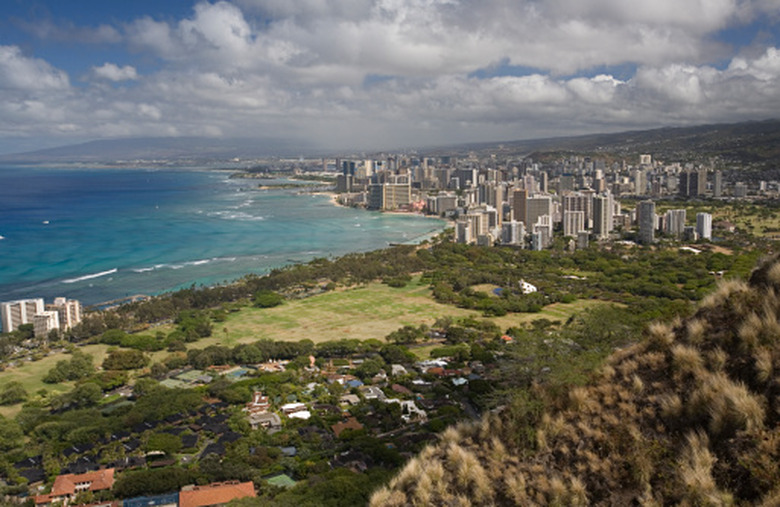The Best Grass Seed For Hawaii
Turf grass is both visually appealing and practical, as it prevents soil erosion. Cool-season grass varieties cannot live in the heat and humidity of the region; the seeds germinate, but the grass perish within two months of planting. Due to Hawaii's tropical climate, only warm-season grass choices grow and thrive there.
Seashore Paspalum
The tropical perennial grass seashore paspalum (Paspalum vaginatum) offers the highest salt-spray tolerance of any grass seed variety, according to the University of Hawaii's website. This can offer a great benefit for beach-front landscapes. It can withstand irrigation with brackish water and grows in regions of the islands that have a low saltwater table level. The grass spreads through a rhizome-based root system and stolons. The grass produces a dense turf with slightly coarse blades. It grows rapidly and offers good tolerance for foot traffic.
- Turf grass is both visually appealing and practical, as it prevents soil erosion.
Maintain the grass at a 1-inch height for the best overall appearance. In areas where the irrigation system is predominantly brackish, consider flushing the soil's surface at least once per year with fresh water so that too much salt doesn't build up. Seashore paspalum seed tolerates full sunlight or partial shade. It requires moist conditions to thrive.
Zoysiagrasses
Plant zoysiagrasses in areas that suffer foot traffic. This warm-season perennial lawn is highly tolerant of being tread upon under normal lawn conditions. It develops a thick, dense coverage. A sod-forming grass, it spreads through both a rhizome root system and stolons. The fine blades of the grass possess a high silica content that makes them stiff. The grass tolerates moderate shade and full sunlight well. Once established, it offers good drought tolerance, according to Texas A&M University's website. In extreme drought the grass turns straw-colored but recovers once it receives water.
- Maintain the grass at a 1-inch height for the best overall appearance.
- In extreme drought the grass turns straw-colored but recovers once it receives water.
For many years the only way to grow zoysiagrass well was by sprigs or sod, but new varieties have been developed that grow from seed. Zoysia japonica establishes itself from seed with ease. The new Zenith and Compadre zoysiagrass form acceptable turf grasses when grown from seeds, according to the University of Hawaii's website.
Bermudagrass
Bermudagrass (Cynodon dactylon) withstands the tropical climate of Hawaii. It offers drought tolerance and tolerates foot traffic well. Once established, it forms a dense turf. It spreads rapidly by stolons and a rhizome root base. It grows best in full sunlight and does not tolerate shade well. Numerous hybrids are available, but they do not produce viable seeds so must be established only through sod or sprigs. Common bermudagrass establishes itself quickly and easily from seed, according to the University of Hawaii's website. Use 1 to 2 pounds of bermudagrass seed per 1,000 square feet of garden space to produce an acceptable lawn. Its drought tolerance makes it an ideal choice for areas of Hawaii, Oahu and Maui where water restrictions are becoming more common.
- For many years the only way to grow zoysiagrass well was by sprigs or sod, but new varieties have been developed that grow from seed.
- The new Zenith and Compadre zoysiagrass form acceptable turf grasses when grown from seeds, according to the University of Hawaii's website.
